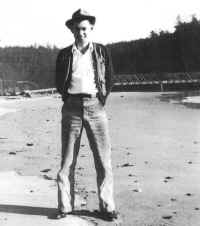Bibliography Background About KRIS
KRIS Big River is Dedicated to W. Francis Jackson
The Institute for Fisheries Resources wishes to dedicate the KRIS Big River project to Walter Francis Jackson, who kept alive the memories of the Big River and the town of Mendocino at its mouth. Without information passed on in his books, much of the history, and its lasting effects on the Big River today, would remain a mystery. Mr. Jackson passed away on February 14, 1997 in the town of Mendocino, where he was born on May 23, 1920. As a child he saw lumber schooners and mill operations, and he later worked in the woods. He witnessed much of what he recorded and visited most of the historical locations that he chronicled in his books, which included Big River Was Dammed, A History Walk Through Little River and Mendocino City: A Daily Journal - 1852-1938. The publisher's note to the latter book serves as a fitting memorial to W. Francis Jackson, whose love of history provides us a priceless window into the past:
Francis Jackson - age 19 on Big River Beach with the old bridge in the background
From Mendocino City: A Daily Journal - 1852-1938
This book is a work of love.
Francis Jackson was born in Mendocino City and has lived there all of his life-with two brief exceptions: four years in the army and three years working in Willits, California. As Francis says, "I will be buried 120 feet from where l was born." He was born in the J. D. Johnson house, a house wedged in between Evergreen Street and the cemetery.
His childhood was spent soaking up the atmosphere that provides the background and unique charm to his writing. He spent time on the river, watched the sawmill operations, fished from logs in the mill pond, rode a log raft down river, watched ships loading in the bay from a bedroom window at his grandmother's, and worked at many odd jobs such as collecting bottles to sell at Mendosa's store for 2 cents each, picking huckleberries to sell at 4 cents a pound, splitting and stacking wood for 75 cents a cord, and working on a ranch for a dollar a day.
Francis attended Mendocino schools, graduating in 1939. He then took a carpentry program at Modesto Junior College. He worked as a mill hand, chopper (timber faller), bucker (cutting logs to length), and barker (peeling bark from the logs). He also made split products - planking, posts and shingles - using broadaxe, froe and drawknife.
He served in the army from 1942 through 1946, landing on Omaha Beach and serving in five European campaigns. He received the Bronze Star with 2 clusters and was cited for meritorious service.
After discharge, Francis returned to Mendocino. The mill had closed in 1938 and the area was still economically depressed, so he worked in Willits for 3 years. While in Willits he re-met, and subsequently married, Marie Flores. They returned to Mendocino and moved into the house he had built there - where they still live. Since then, he has worked in construction, including being the prime contractor for the extensive restoration of Kelley House. He has worked on most of the historic structures in Mendocino. In fact, a message from Francis can be found inscribed on the topmost knob of the Presbyterian Church steeple.
Francis has been active in the community in many ways. The American Legion Post, Lions Club, Masonic Order, and Rotary Club have all benefited from his active participation and leadership. Life-long involvement in the logging industry admirably prepared him for his interest in the history of the area. About 20 years ago, he began research on his first book, Big River Was Dammed. A History Walk Through Little River followed. He is currently doing field research on a series of maps covering the area between Caspar Creek and Greenwood/Elk. He has been walking the streams, creeks and rivers seeking out the locations of logging dams, camp sites, etc.
This book is in Francis' words and reflects his knowledge and feeling for the area. It also should be noted that Francis personally typed the pages just as you see and read them. He selected, titled and formatted the photographs and worked countless hours on the index. This book is a very personal effort, so we repeat: this is a work of love-love for a special place in a man's heart.
Mendocino Historical Research, Inc. Publisher

